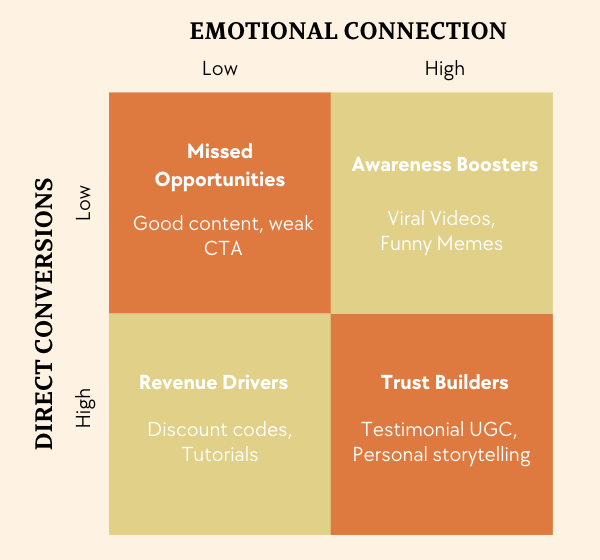A Simple Way to Think About Content
When reading Scott Berinato’s “Visualizations That Really Work”, the one thing that stood out to me was that the best visuals do more than just look good, they solve a problem. Berinato made the strong point that we should choose visuals that match what we’re trying to say and at times, creating a simple framework that others can understand is key.
My experiences creating performance-driven social media content for a wide range of brands, has led to me developing my own 2x2 matrix for Audience Connection vs. Conversion Matrix. It helps us think about what types of content actually work for our audience and for our goals.
BREAKING DOWN THE MATRIX
The X-Axis is Emotional Connection
The Y-Axis is Direct Conversions
These both go from low to high and gives us four quadrants:
1. Awareness Boosters (High Connection, Low Conversions)
Viral videos, funny memes or trendy TikToks. These grab attention and make people feel something but don’t necessarily drive a purchase right away. People will laugh and share this content, but they’re not buying anything yet. Their role is to widen the top of the funnel.
2. Trust Builders (High Connections, Medium Conversions)
Testimonial-type UGC videos, reviews and personal storytelling. This content connects as well and nudges people toward a decision. It builds credibility so audiences feel safe moving forward. For instance, a real customer talking about how a skincare brand cleared up their face. It’s relatable and compelling.
3. Revenue Drivers (High Conversions, Medium Connection)
This quadrant is all about making it easier for people to take action. Discount codes, tutorials and “shop now” or “click here” clips. They’re practical and push for results. An example is when a creator drops their own code as a CTA at the end of the video.
4. Missed Opportunities (Low Connection, Low Conversions)
This quadrant is when content is nice to look at but does not connect nor convert. This is the weakest quadrant and can be seen as effort wasted. Such as, a perfectly polished ad.
Visualizations do not need to be fancy or elaborate in design, it just needs to help you think clearly and explain your point. This 2x2 shows why different content exists and helps creators and brands see gaps in their strategy.
When you’re making content strategy decisions, ask yourself where the piece falls in the matrix. If it doesn’t build awareness nor conversions, it may be a missed opportunity.
If your content builds emotion but not action, you’ve only done half the job.
